When people ask me whether living abroad makes me miss Russian food, I always reply with a firm “no”. Not because I don’t love it, but simply because I can prepare most of Russian dishes in the convenience of my own kitchen. For the same reason I almost never go to Russian restaurants abroad, except for one time in Brighton Beach. Borscht? Not a problem, gimme those beets! Blini? I make them 3 times per week for breakfast – takes me no longer than 15 minutes. Pelmeni? All I need is 10 episodes of Friends to keep me company and in three hours I got dinner ready. And then there’s Russian cottage cheese… or tvorog as we call it.
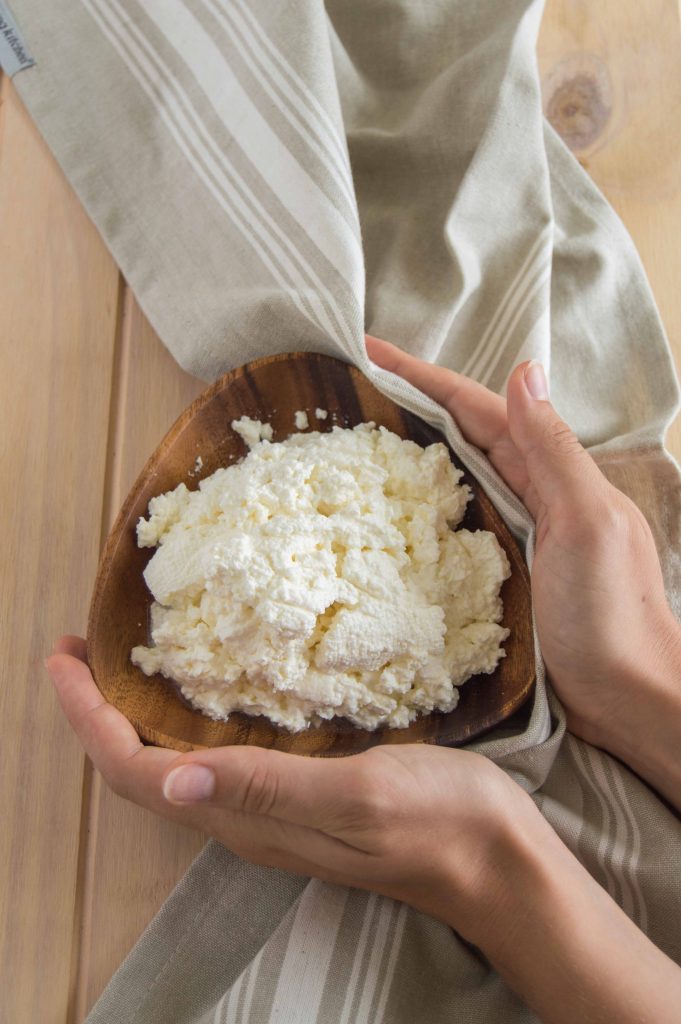
Freshly made cottage cheese (or tvorog as we call it in Russia).
For the purposes of this post I will use the terms “tvorog” and “cottage cheese” interchangeably, since both of them refer to soft lumpy cheese made from the curds of sour milk. That is in theory. In practice, cottage cheese I have tried abroad doesn’t stand comparison with Russian tvorog.
Tvorog is not something you make in Russia, you buy it from a grocery store or from a granny at the market. There are plenty of varieties for every taste: from fat-free option (not my scenario) to 9% fat cottage cheese (now, that sounds good) to a sweetened version of tvorog with raisins called tvorozhok which, if you translate it literally, means “little cottage cheese” or “baby cottage cheese”. Can we stop for a second and admire the beauty of Russian language? Baby cottage cheese must be the most romantic name for a type of food!
I never realized how much I love Russian tvorog until my travels started. Actually, the realization didn’t sink in until I returned home and couldn’t help eating cottage cheese every single morning for two weeks. And so the ritual was born. When I plan a trip to Russia my mom asks what I would like to have upon arrival, knowing full well that all I need is cottage cheese, rye bread, and pickled cabbage. Don’t worry, I don’t eat all three at the same time.
When abroad, I am left with petty imitations of cottage cheese that are not worthy of the name. If you want to understand how delicious cottage cheese is in Russia, consider this: we eat cottage cheese on its own. We don’t serve it on a toast or alongside an omelette for breakfast. Tvorog mixed with a tidbit of sour cream and sugar is a great breakfast in itself.
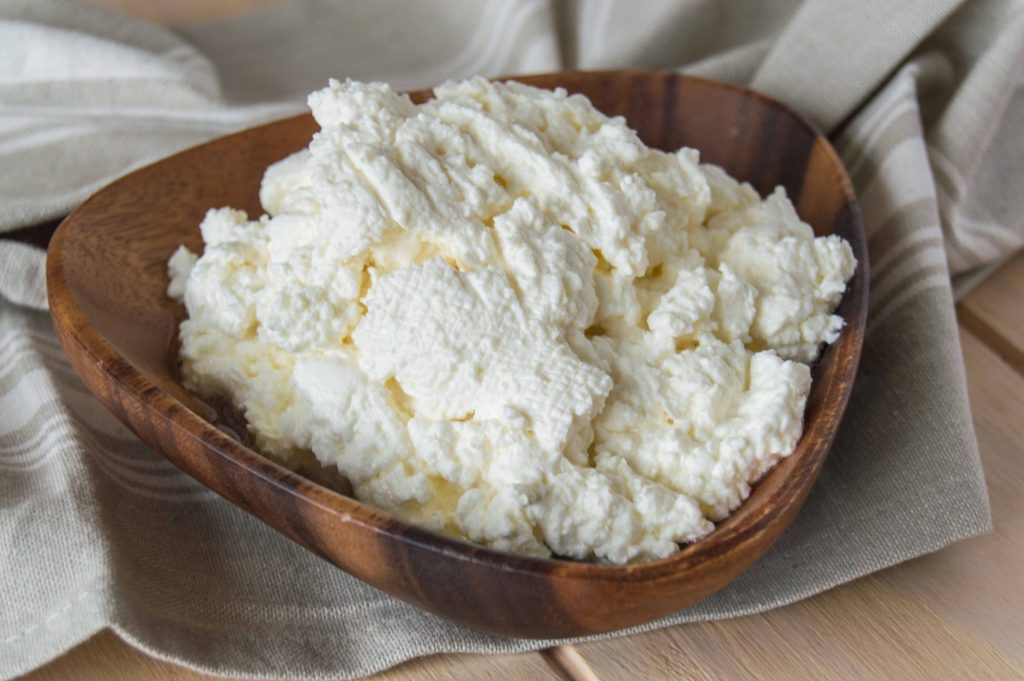
Three Homemade Tvorog Recipes
When cravings kick in there’s nothing you can do but try to perform a miracle of transforming milk into cheese yourself. As Demetri Martin correctly pointed out in his stand-up show: “Food is tricky, like milk: It starts out good, then it becomes bad, then it becomes disgusting, then it becomes dangerous, then it becomes cheese. Way to turn it around, milk!”
You’ll find a multitude of tvorog recipes online. In my opinion, there are three main ways of preparing tvorog at home: the right one, the realistic one, and the “Nobody’s got time for that!” one.
The Right Way of Making Tvorog
The right way requires two ingredients: milk and patience. Leave milk outside at room temperature and wait for several days. Bacteria in milk will do all the work for you turning lactose into acid and causing milk to curdle without actually spoiling. The resulting product is called clabber.
According to the Joy of Cooking,
“Clabber, much like cultured buttermilk or yogurt, is milk that has soured to the stage of a firm curd but not to a separation of the whey.”
Leave it for another day and you will see that clabber is curdling even more and whey (greenish liquid) starts separating from curd. Now all you have to do is strain it and voila! Only one little problem: for this method you need raw unpasteurized milk which is hard to find in United States where I live now.
The Realistic Way of Making Tvorog
Since getting raw unpasteurized milk is not an option, let’s be real and work with what we have – pasteurized milk. In order to help milk turn into cheese we can add acid ourselves instead of waiting for bacteria in milk to produce it naturally.
My tvorog recipe is adapted from farmer’s cheese recipe by Natasha’s Kitchen. I first made it about half a decade ago, but as it happens, I did a few tweaks of my own over the past years. I don’t use the oven, but heat the milk on the stove instead (faster!). When heating I stir the mixture carefully to ensure it heats up evenly.
The classic way is to use cheese cloth to strain tvorog, but I find that a fine strainer works well at catching even tiny bits. Bonus point: scraping tvorog off a strainer is so much easier than off the cheese cloth.
For homemade tvorog recipe you will need 2 parts milk and 1 part buttermilk, which is, essentially, soured milk. Combining the two and leaving it at room temperature will help to speed up the process. After you leave the mixture in warm place for 24 hours, it will look like this:
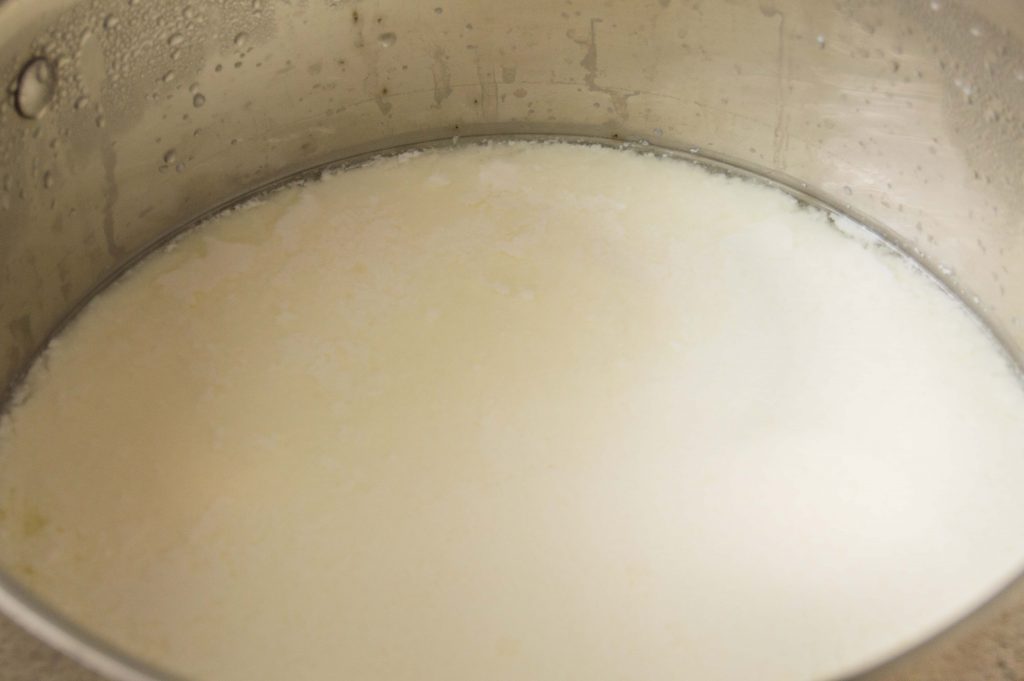
After 48 hours it will curdle even more:
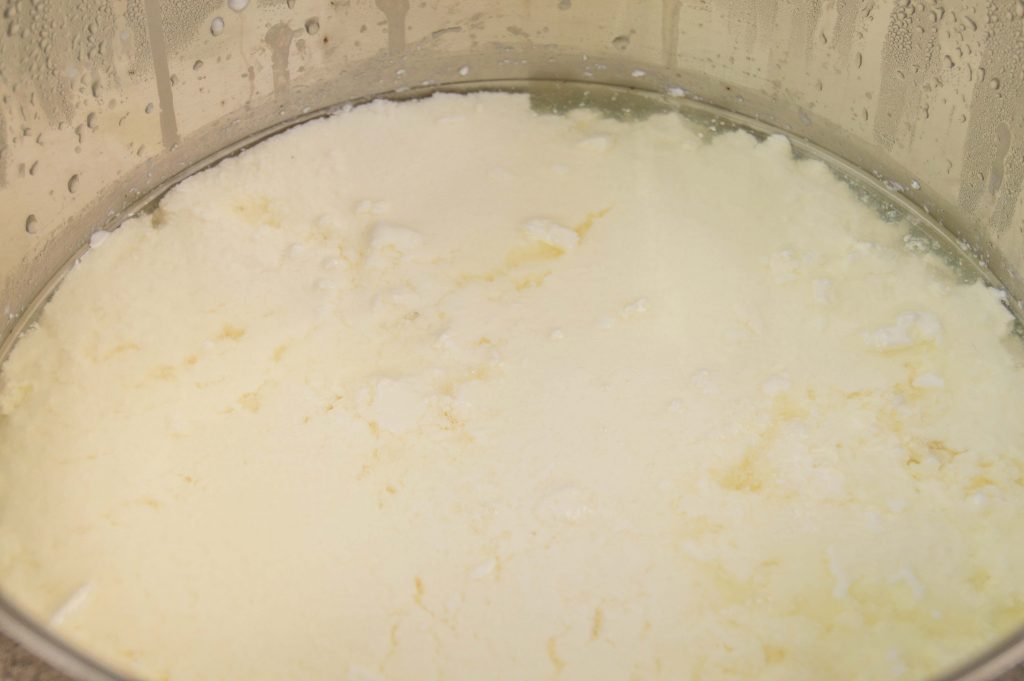
Separate the whey from cheese using a strainer…
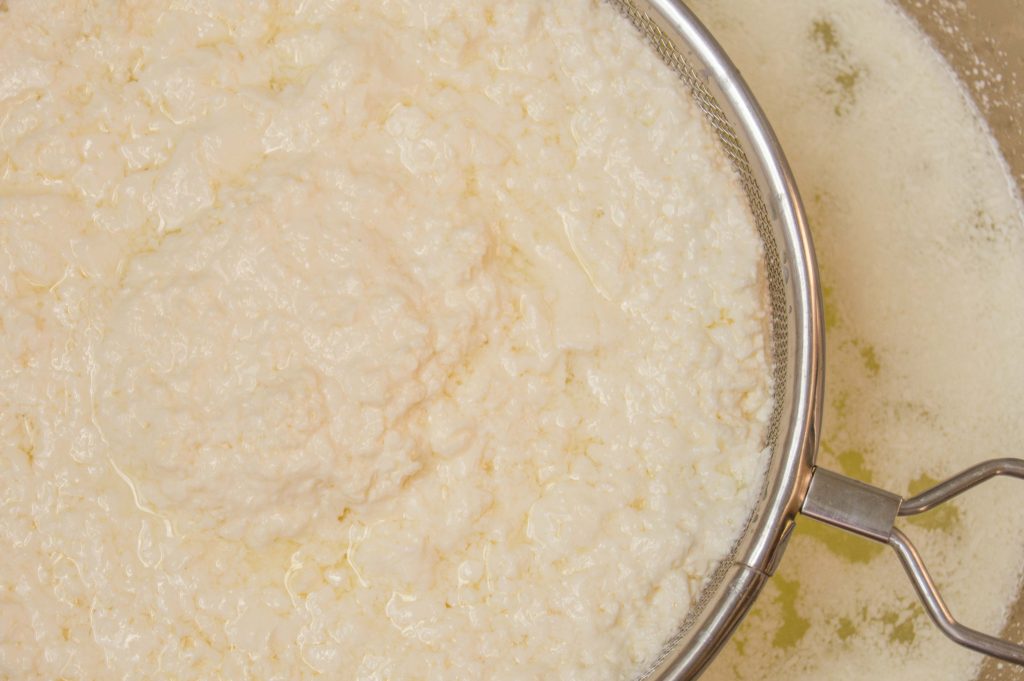
… and it’s ready to eat! (check the full recipe below)
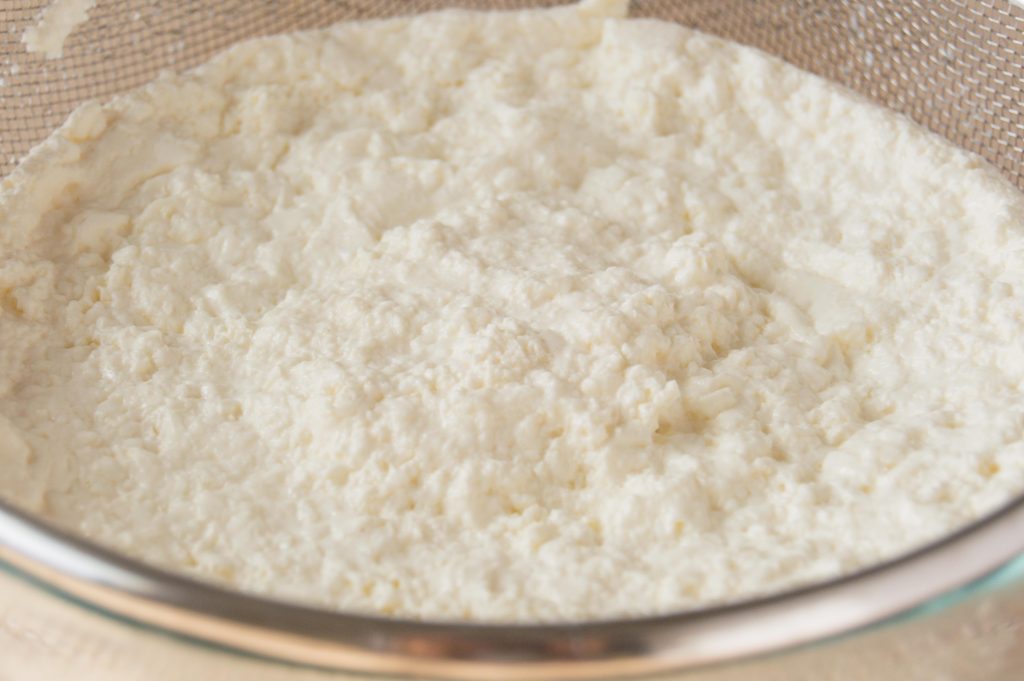
I know that the idea of preparing something for three days sounds scary but there’s very little work involved on your part: acid does all the work for you. By the way, the whey that you separate from cheese is edible too, you can use it to make delicious crepes!
The “Nobody’s Got Time For That” Tvorog Recipe
The name is pretty self-explanatory. Although the recipe above is unpretentious, it might be hard to keep your mind on something like cottage cheese for three days. Or, maybe, the craving is so bad you absolutely, no questions asked, must have tvorog right this minute! There’s a way to make it which will only take 30 minutes of your precious time.
Once again we are going to add acid to milk ourselves, but this time we will use a more concentrated option: lime or lemon juice. Acid works slow if you leave milk at cold or room temperature (as we have seen in the previous recipe, it took over 48 hours), so in order to speed up the process we need to heat the milk up. Then the separation of whey happens within minutes. The only disadvantage is that the yield in this recipe is low: approximately 2 cups of cottage cheese from 1/2 gallon of milk (check the recipe below).
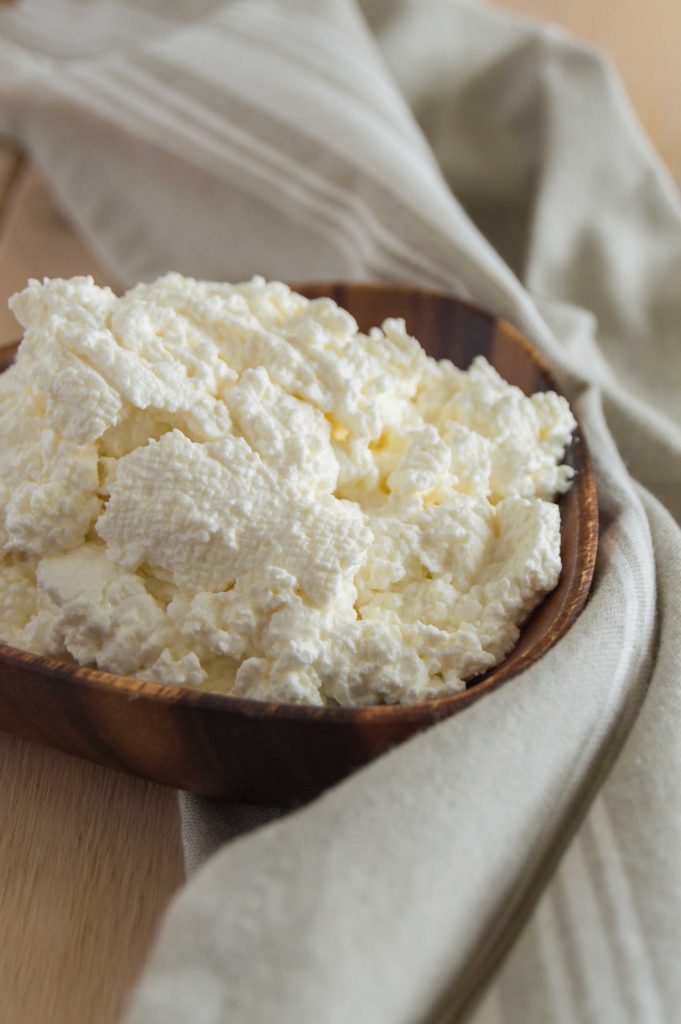
The Science Behind Making Russian Tvorog
The reason why acid makes milk curdle is a little complicated and described well in The Kitchn article “Food science: why lemon makes milk curdle?”
“The first thing to realize is that milk is actually made up of a lot of different components, the main ones being protein, fat, and water. When it comes to curdling, we’re mainly concerned with one specific milk protein called casein.
Normally, little groupings of casein float around in the milk without bonding to anything. These groupings (technically called micelles) have a negative charge, which makes them repel other groupings of casein and keeps the casein evenly dispersed in the milk.
When milk becomes too acidic, like when we add lemon juice or when it goes sour, the negative charge on the casein groupings becomes neutralized. Now instead of pushing each other apart, the casein starts to clump together. Eventually large enough clumps are formed that we can actually see the separation, and then we have curdled milk.”
The recipes below will, probably, be most popular among Russian expats who, just like myself, are suffering from lack of good tvorog. If you are not Russian, you might be wondering: why go through the trouble? Because once you make it at home you will never be able to eat store-bought cottage cheese again — it doesn’t stand comparison. Besides, there are many delicious dishes you can make using Russian tvorog. Here are three of my favorite recipes using Russian cottage cheese.

The Realistic Way of Making Tvorog
Ingredients
- 1/2 gallon whole milk
- 1/4 gallon buttermilk
Instructions
-
Leave milk and buttermilk on the counter until they reach room temperature (I leave mine overnight).
-
Combine milk and buttermilk in a deep pan and place over low heat. Heat the mixture up until it’s warm when you touch it with your finger. Stir only slightly.
-
Remove from heat, cover with a lid and leave in warm place for 24 hours (I leave it on the counter next to the stove)
-
In 24 hours place the pan over low heat again. Heat up until it’s warm to touch. Stir a little to make sure the mixture is warm throughout. Remove from stove and leave for another 24 hours in warm place.
-
In 24 hours heat up the mixture for the last time. At this point cheese should completely separate from whey (greenish liquid). (*In rare case when the whey doesn't separate after 48 hours, heat up the mixture over low heat until it does. At higher temperatures separation happens much faster.)
-
Use a fine strainer lined with cheese cloth to strain cottage cheese. Leave it in strainer for 5-6 hours or overnight to make sure that all whey has drained.
Recipe Notes
After it's done, keep cottage cheese refrigerated.
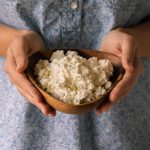
The Fast Way to Make Tvorog
Ingredients
- 1/2 gallon milk
- 6 limes
Instructions
-
Squeeze juice out of limes into a cup and set aside.
-
Place a pan with milk over medium heat and bring it to almost boiling temperature. It’s a bit tricky: milk should be hot enough, but not bubbling.
-
Reduce the heat, add lime juice and mix it.
-
Cover the pan with a lid and leave for 15 minutes on low heat.
-
When milk has curdled and whey (greenish liquid) separated, use a very fine strainer lined with cheese cloth to strain cottage cheese. Leave it in strainer for 30-40 minutes to make sure that all the whey has drained.
Recipe Notes
This recipe doesn’t have to be precise. I usually prepare cottage cheese at a glance. So if you see that after adding lime juice milk isn’t curdling well, don’t be afraid to add a little more. Some limes are juicier than others. Make sure to add a little at a time.
Don’t pour out the whey. Although it looks extremely weird, you can use it to make delicious crepes!
Pin for later:
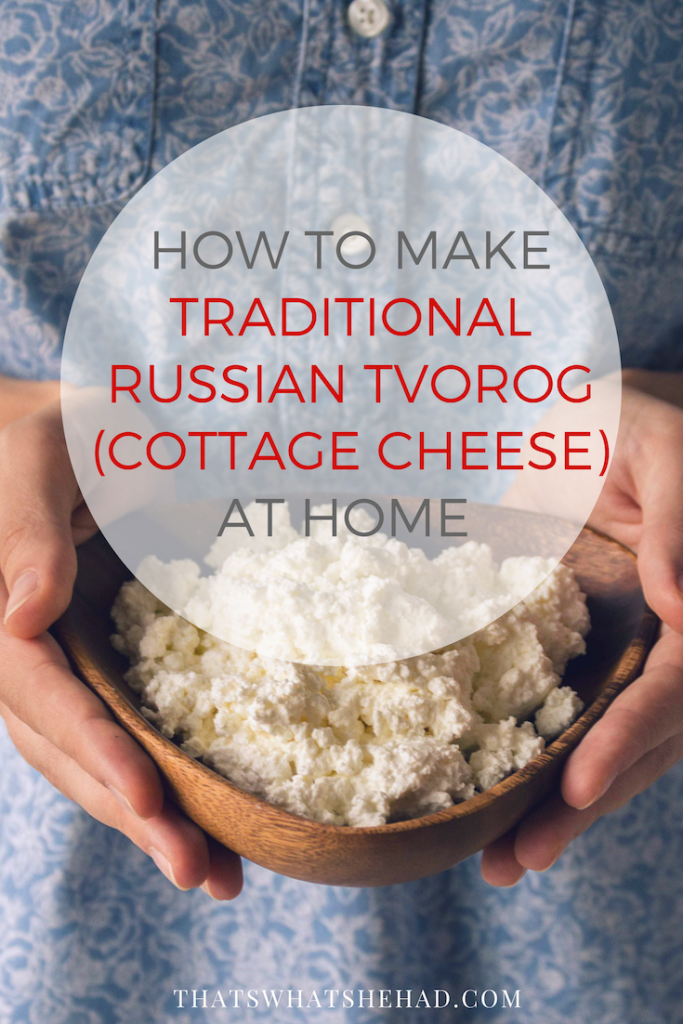





Thank you, nice read.
is there a difference between using the really fast vs few day process in terms of the final product? i’m trying to make some to make syrok
In my experience, cottage cheese made in 48 hours is slightly softer and creamier than the fast one. But the main difference is in yielding. Faster method yields much less cottage cheese so I usually only use it if I am in a hurry. Let me know how it worked out for you! 🙂
How and for how long can the whey be stored?
Hey Lisa! I store it in the fridge for about a week!
Oh wow, this is quite different from the methods I’ve used to make tvorog! I love how many options there are for making it. I was lucky enough to be gifted a kefirniy grib, but, before that, usually mixed in a spoonful of sour cream or a cup of plain kefir into milk, covered loosely, and let it sit out on the counter for 1-3 days (however long it took to become gelatinous), then either placed the container into just-boiled water for an hour (if using a jar), or into the oven for a couple of hours until the solids separated from the water, then stained with cheese cloth. I killed at least one grib by forgetting to remove it for the heating processes, had a few close calls with my current ones now, so I guess that’s worth noting. I also loved your Demetri Martin joke reference– it’s so true!
Hey Rhea! Thank you for sharing your ways of making tvorog! I guess, all of those methods are basically the same: add something sour, whether it’s buttermilk, sour cream, kefir, or lemon juice, then leave at room temperature and heat it up a little to speed up the process. I might try using kefir or sour cream like you, just to see whether the end product differs in consistency or taste.
That Demetri Martin joke cracked me up 🙂 When you really think of how cheese is made, it’s kinda disgusting 😀
hi. thank you for sharing these recipes. I tried the fast method but the milk refused to curd even after I added 2 more limes. I’m not sure what happened. what type of milk did you use? I used 3.25% whole milk.
Hey Zizi! I also use 3.5% whole milk (that’s the highest fat percentage I can find). Making cottage cheese is really about 3 things: acid, heat and time. If the milk isn’t turning into curds, I would gradually increase each of them: add more lime juice, turn the heat up (not quite boiling, but almost boiling), and wait for about 5-7 minutes. If it still doesn’t curd, I’d add more acid, turn the heat a little more up and wait again.
I once had limes that just weren’t juicy enough. I’d squeeze them and get only a few drops, so I ended up using 4 times the amount I usually use. Increase acid, heat and time slowly and eventually the milk will curd, cos it’s really just science, there’s no way around it.
Let me know how it goes 🙂
Yulia,
Thank you for the recipes! My wife misses it so much! She is Russian and I am American, it is difficult to find some of the Russian foods she enjoys here. Depending on where we are sometimes we can, but even then it isn’t always so great. I have been trying to figure out how to make what she likes and misses so she can have it wherever we go. I sincerely appreciate you putting this out. I do have a question though, the right way, how long do we leave it out? Is there anything more to it than leaving out, then straining it? Neither one of us has ever made it before. I am hoping she really likes it!
Also, your post, “The Homesick Russian…” was excellent! I can identify, haven’t felt like I belonged anywhere in quite awhile, lived in Japan for 6 years and was out of country for ten years without really coming back. I definitely missed home but I remember distinctly how much had changed when I did return, and your expression of how much Russia still means to you helps me to understand some of the feelings my wife has expressed. Thank you.
Hi Jeff!
Sorry it took me a while to reply. I’ve been traveling for the past few weeks and wasn’t active online. I am so glad my post “The Homesick Russian…” struck a chord with you. It’s one of the most personal and heartfelt pieces I’ve ever written, so it means a lot when other people can relate. I’ve heard that Japan is one of the countries where it’s pretty much impossible to truly become a part of society, even if you lived there for decades. I can only imagine how hard it’s been for you.
As for cottage cheese, usually I leave it out for 4-5 hours or even overnight. But it’s really easy to see when all the liquid has separated. You won’t miss it! Happy cooking to you and your wife 🙂
Hi Yulia! Thank you so much for the tvorik recipe! You explained it very well and it came out delicious. We lived in Russia for close to 14 yrs and really miss the people….and of course the food. Your site is a great resource…спасибо!
Oh it makes me so happy that you tried out my recipe and it turned out well! Thank you for the compliments to my blog!
14 years is a long time! Which city did you live in?
We lived in several cities: Saratov & Ryazan mostly.
I’ve actually never been to either of them. Got some traveling to do around my own country)))
I have been making turo, Hungarian name for Tvorok, for quite a while now As I can not stand the north american cottage cheese. The only real difference that I do is put the pot, uncovered, in a 200 degree F oven after the initial curdling on the counter, in a few hours the curd becomes solid and is ready to be drained of the whey. Normally I start it out in the evening and by the next day it is ready for the oven, and so it usually only takes w days to make. We love it and find all sorts of uses for it. For instance we mix it with a small amount of Greek yogurt, lemon zest and a smidgeon of sugar and use it to fill palacsinta (Hungarian crepes) along with some fruit. My whole family loves them this way.
Hey Judith!
Thank you for sharing your way of making tvorog! I can see how keeping the pot in the oven would speed things up a bit. I’ve actually never heard of turo or palacsinta, but the way you describe them sounds amazing! I also love using tvorog in all kinds of different dishes: as a stuffing for blini (Russian crepes), in vareniki (Ukrainian dumplings) or to make cottage cheese patties.
Спасибо Юлия! Thank you for explaining three different variations. I was lucky to find raw organic milk at a local farm shop today. So I am wondering how it will turn because I mixed milk and kefir and warmed it up very slightly in warm oven. Now leaving it overnight to see how it looks tomorrow. I hope I am taking the right approach since I am used to making творог the quick way with vinegar. This is first time I use raw milk. Any thoughts?
Hi Sabina! So happy my post was helpful!
I’ve never used raw milk too make tvorog — couldn’t really get my hands on it in our day and age of supermarkets and everything pasteurized. But I don’t see why it wouldn’t work the same or probably even better. Especially, that you added a souring agent like kefir and heated it up. Please, do let me know how it works!
Hello Yulia, I am really getting my hopes up here! Been living in the States for almost 8 years and I can definitely say I MISS TVOROG! And although I have 3 Russian stores all very close to me, the price bites a bit if I really ate it as much as I would love to:). I tried a recipe in the past not realizing which kind of milk I needed and pasteurized milk definitely clabbered but was sooo bitter that I put off my attempts for the better day. I think it finally came ha ha. One question, I like my tvorog on a bit of a sour side. I am thinking of following the longer version of the recipes with bigger yield. How is it taste wise, pretty mild? And is it possible to effect the flavor?
Hi Natasha,
I am sorry for the late reply! I’ve been traveling and didn’t have consistent access to Wifi. It makes me really happy that you are going to give this recipe a try. I’ve been mainly using the longer method myself for the past years because the taste is much better this way, the texture is creamier, and well yea.. the yield plays an important role too 🙂 I only used pasteurized milk in both methods since it’s not that easy to find fresh milk. Mine never turned out bitter, so I hope that won’t happen to you again. The taste is quite mild I would say, which is how I prefer it, but I wonder if adding more buttermilk would help? I would try the original recipe as is first and see how you like it. Then play around with quantities. Hope that helps! Do let me know how it goes 🙂
Seems pretty fool proof! Still worked with my ultra pasturised American milk!
Hey Kat!
So happy the recipe worked for you!
This is how my mom always made tvorog and I make it too! We grew up in the US and had to make it ourselves if we wanted some With the strainer, if you want even less of a mess to clean (we all do), place two layers of paper towels into the strainer. When every thing drains, just throw the paper towels away! I’ve started using this method recently and love the simplicity! I only drain it in the cheese cloth now if I want the round look.
Angelina,
thank you for sharing and sorry for my late reply! I’ve never used paper towels – it’s a neat idea, I should try it out next time! I currently use either just a very fine strainer or a strainer lined with cheese cloth sometimes, but that does require some more cleaning afterwards.
I dutifully did the Realistic Way method and it was–as expected–a failure. Indeed, all I yielded was yogurt lacking normal firmness. Big waste of resources, time and effort.
Dear Mattathias,
I am sorry it didn’t work out for you! In case you want to try it again – which from your tone of voice you probably won’t – the way to turn yogurt into actual cottage cheese is to keep increasing the acid and the heat. This means: put the pan on low heat, add some lemon juice and wait. If it still doesn’t work, keep adding lemon juice and keep slowly heating it up. It will firm up eventually, there’s no way around it.
There may be many reasons why the recipe didn’t work for you, but off the top of my head: it’s winter and maybe it’s too cold in your kitchen.
Just one question: why “as expected”? 🙂 You should be more optimistic when you take on a new project 🙂
Hi there, I tried realistic way of making tvorog and it turned out to be the best tvorog I’ve ever tried! Thank you so much for the recipe!
Then I wanted to increase the quantity of tvorog so I increased the quantity of ingredients: 3l of milk and 1.5 l of buttermilk.
The only thing that I forgot is to keep it at the room temperature: I poured cold milk and buttermilk into a pan and started heating it up.
The end result was that there were a lot of small tvorog flakes and the yield was much less than in the orginial try!
Could you tell me what was my main mistake? Increasing the quanitur, using cold ingredients or something else? I would highly appreciate it!
Hi Alena,
I am sorry it took me a while to reply! I am really happy you loved the tvorog! If you are making it “the realistic way” (over several days), the quantity shouldn’t be a problem. I’ve used as much as 4l of milk and 2l of buttermilk. It can be going from really cold to very hot too quickly. Sometimes I forget about the milk on the stove and turn it off way too late, when the mixture is too hot, then the end result is not very good. I would make sure to stir it a little more frequently (while on the stove) to make sure the whole mixture heats up evenly (not hot on the bottom, cold on the surface) and do it over very low heat, even if it takes longer (which it will because the sheer quantity is so much bigger). I hope this helps! Thank you for leaving a comment!
Yulia